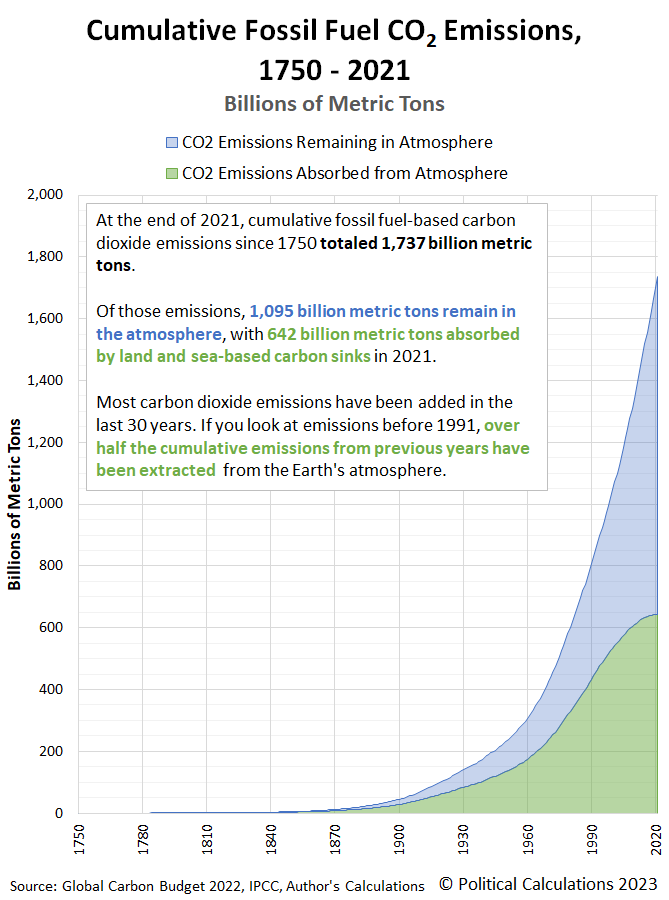Since the dawn of the industrial revolution in 1750 through 2021, people have burned enough coal, oil, natural gas, and other fossil fuels to add about 1,737 billion metric tons of carbon dioxide in the Earth's atmosphere.
But because of the Earth's carbon cycle, a large percentage of those emissions have been extracted from the air. Through 2021, land and sea-based carbon sinks have removed about 37% of total historic CO₂ emissions.
As a general rule of thumb, the older the fossil fuel emission, the more of it has been removed from the atmosphere, reducing the concentration of carbon dioxide in the air below what it would otherwise be without those natural processes. The following chart shows the history of cumulative fossil fuel emissions from 1750 through 2021, including the estimated amount of carbon dioxide cumulatively absorbed over that time.
Through 2021, about 642 billion metric tons of carbon dioxide have been removed from the Earth's atmosphere by the planet's natural carbon cycle. That leaves about 1,095 billion metric tons that have not.
The chart also shows a widening gap between the amount of carbon dioxide emitted from fossil fuels and the amount recovered through the carbon cycle. That's attributable to two factors. First, CO₂ emissions have been increasing rapidly, primarily due to China's growing carbon footprint over the last 30 years. Second, the newest emissions have had the least amount of time in which the natural carbon cycle can do its work.
That time matters. If you look closely at the chart to examine the cumulative emissions produced through 1990, you'll find that over half those CO₂ emissions are no longer present in the atmosphere. Because of the effect of the carbon cycle in absorbing older carbon dioxide emissions, the amount of carbon dioxide currently in the atmosphere represents more a consequence of what has been happening in the last 30 years than what happened in the more distant past.
The natural carbon cycle is only able to remove above 80% of these carbon dioxide emissions over a 300 year period. The remaining 20% takes much longer to absorb because it requires geologic processes that occur over thousands of years. Much of the carbon capture and storage (CCS) technologies in development today are being developed with an eye to reducing the initial amount of CO₂ emissions produced and to, in effect, mop up the long-term remainder.
Analyst's Notes
Bonus chart! Because the featured chart illustrates the exponential growth of fossil fuel-based carbon dioxide emissions that spans several orders of magnitude, here's a link to a second chart presenting the same data using a logarithmic scale. We opted to feature only the chart showing the data on a linear scale since it better illustrates the relative percentage share of absorbed carbon dioxide emissions with respect to the total.
References
Friedlingstein et al. Global Carbon Budget 2022, Earth System Science Data, 11 November 2022. DOI: 10.5194/essd-14-4811-2022.
Political Calculations. How Long Does Carbon Dioxide Stay in the Atmosphere? [Online Article, Tool]. 19 July 2023.
Image credit: National Oceanic and Atmospheric Administration. Carbon Cycle Illustration. 2019. Public Domain Image.

